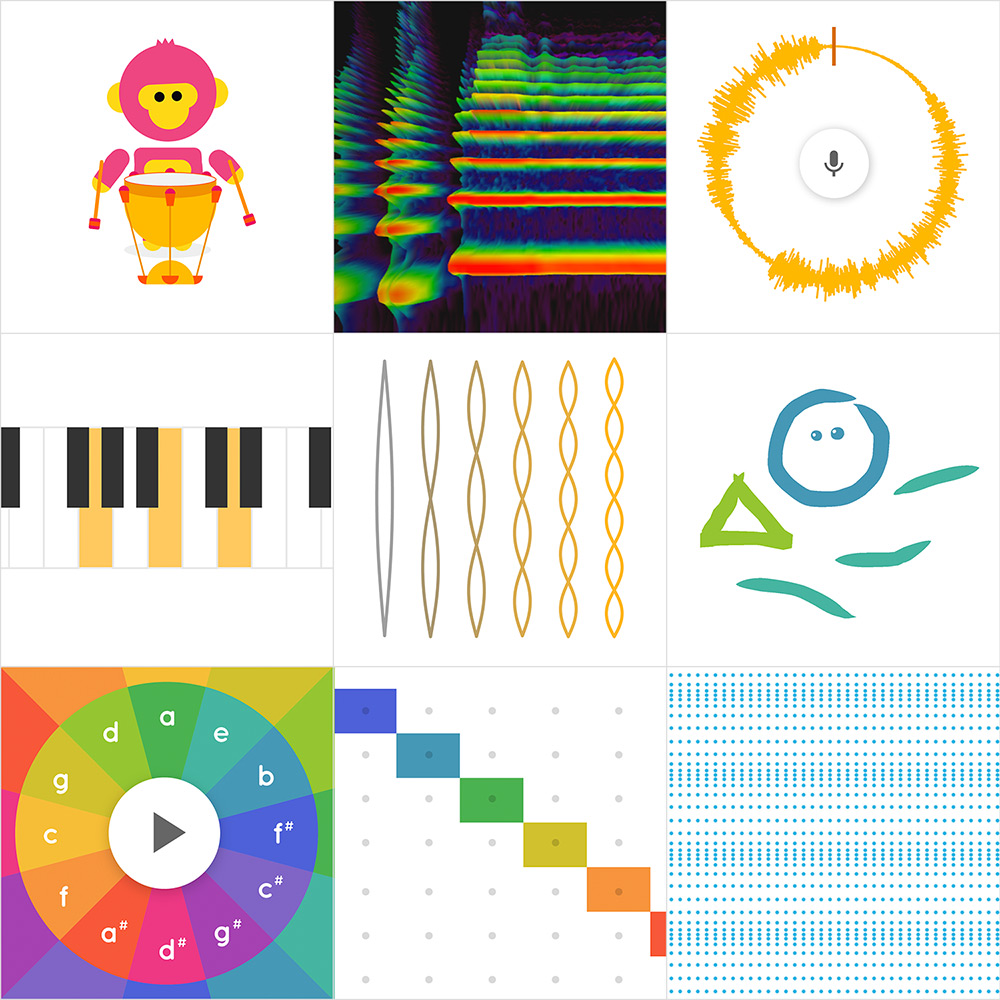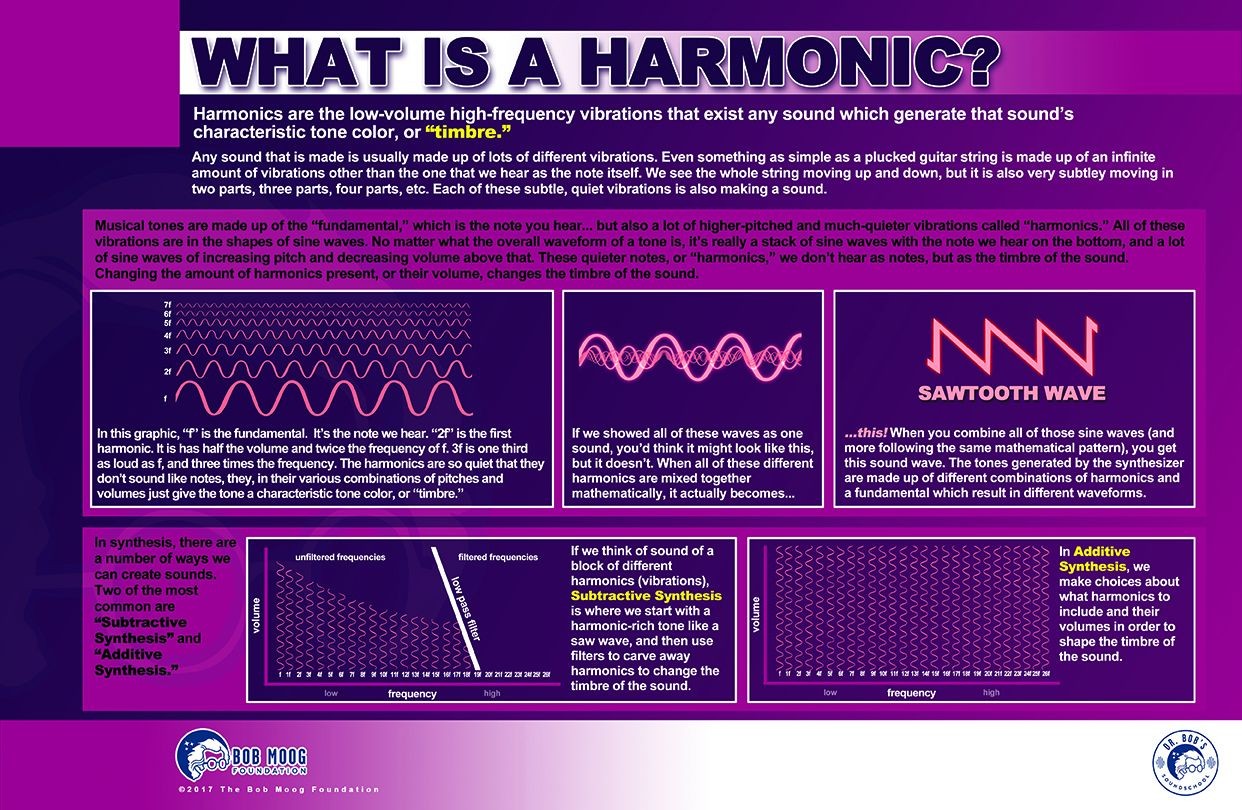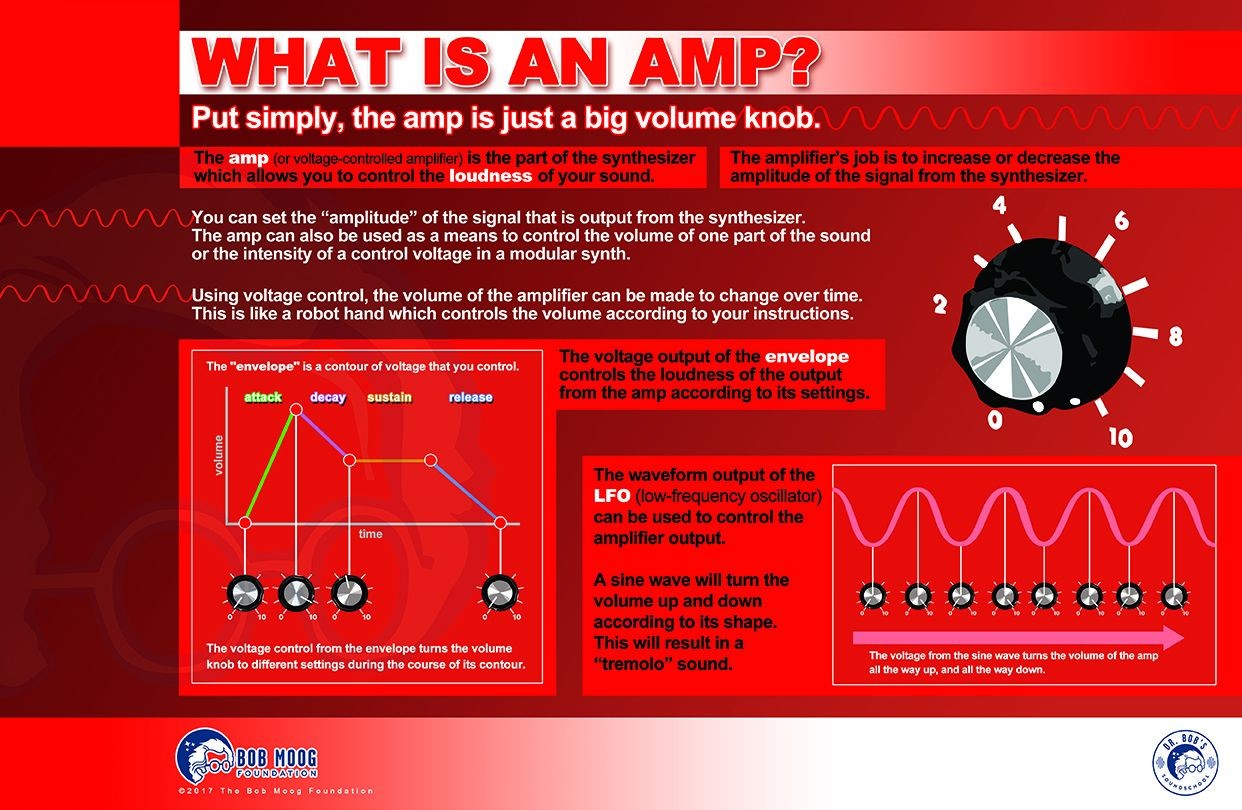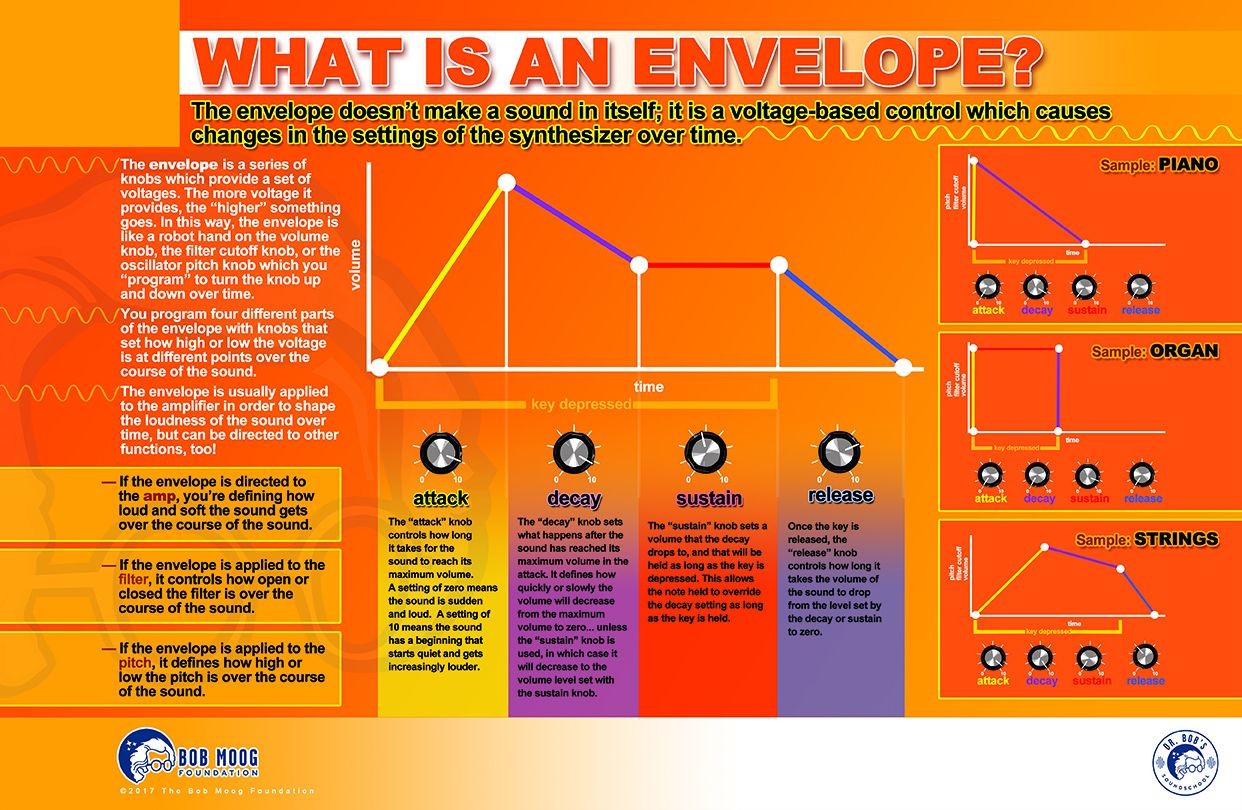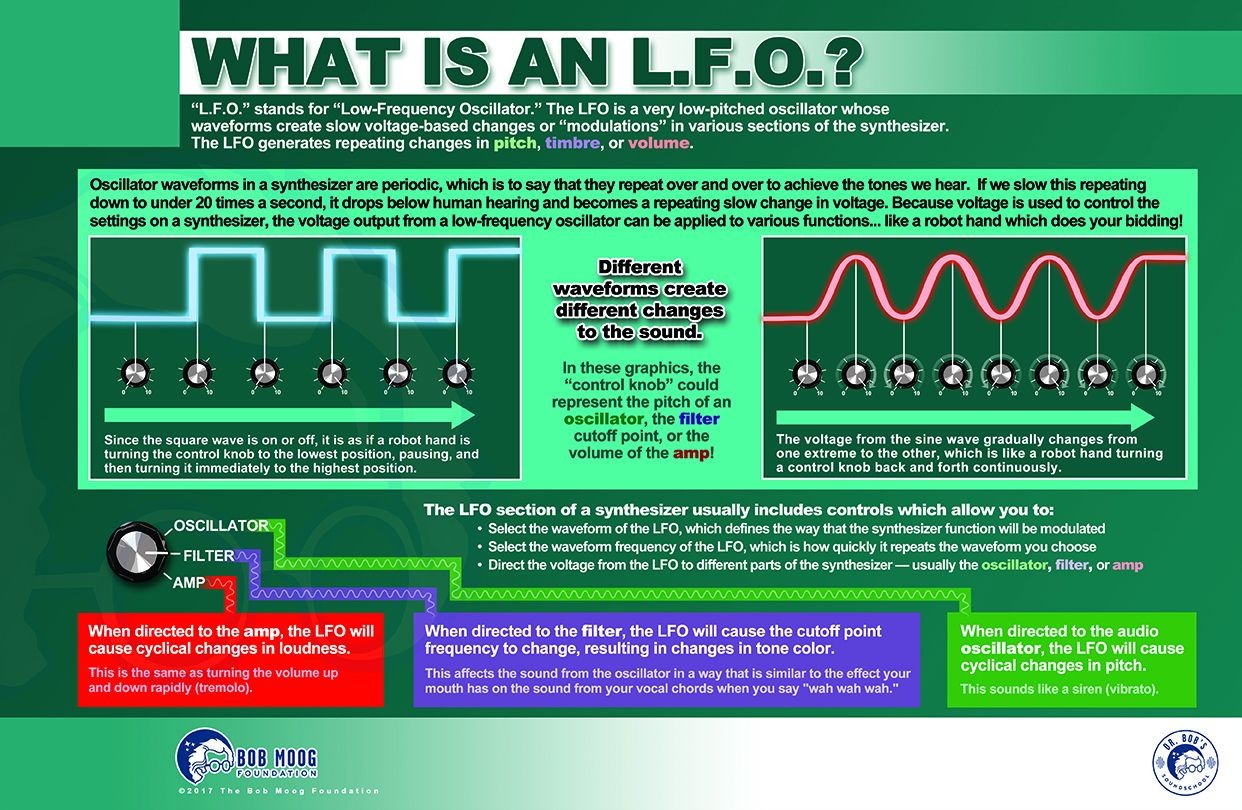Synthesis Fundamentals from the Bob Moog Foundation, Ableton’s Learning Synths, and Chrome Music Lab

The Bob Moog Foundation and the MIDI Association
The Bob Moog Foundation and the MIDI Association have had a close working relationship for many years. When we talked to Michelle Moog-Koussa, she graciously agreed to provide some materials on synthesizers for the May Is MIDI Month 2020 promotion.
The series of posters in this article are available for purchase here with the proceeds going to the Moog Foundation.
There are also some Youtube videos from The Foundation of Synthesis six-part tutorial series with Marc Doty. This course is available in our video curricula.
We have combined it with Ableton’s excellent interactive website for Learning Synths, Google’s Chrome Music Lab, and text from synth master Jerry Kovarsky, monthly columnist for Electronic Musician Magazine and author of Keyboard For Dummies.
Together these elements come together to make a great introduction to synthesis appropriate for students and musicians of all ages and levels. There are links to more information in each section.
MIMM 2020 Webinar
The MiniMoog- The Synth That Changed the World
Saturday, May 9, 10 am Pacific
Join us this Saturday at 10 am Pacific, 1 PM Eastern and 6 PM Greenwich on MIDI Llve to hear a panel discussion about the Minimoog, one of the most influential synths of all time.
Panelists include Michelle Moog Koussa and David Mash from the Bob Moog Foundation Board of Directors, Amos Gaynes and Steve Dunnington from Moog Music, and synth artists and sound designers Jack Hoptop, senior sound designer for Korg USA, Jordan Rudess, keyboardist for Dream Theatre and President of Wizdom Music (Makers of MorphWiz, SampleWiz, HarmonyWiz, Jordantron), and Huston Singletary, US lead clinician and training specialist for Ableton Inc.
Composer Alex Wurman Provides Sonic Meditation For All Mothers as Part of Moogmentum in Place
The Bob Moog Foundation is proud to announce that EMMY® Award Winning composer Alex Wurman will perform a Facebook live stream concert to benefit the Foundation on Saturday, May 9th at 8pm (ET) / 5pm (PT), the eve before Mother’s Day. Wurman will inspire a worldwide audience with A Sonic Meditation for All Mothers on a Yamaha Disklavier and a Moog Voyager synthesizer. The performance and accompanying question and answer, which will last approximately an hour, is meant to offer musical solace during these times of difficulty.
Listen to the Synth sound in the video and then check it out for yourself via the link below.
Synth Sound
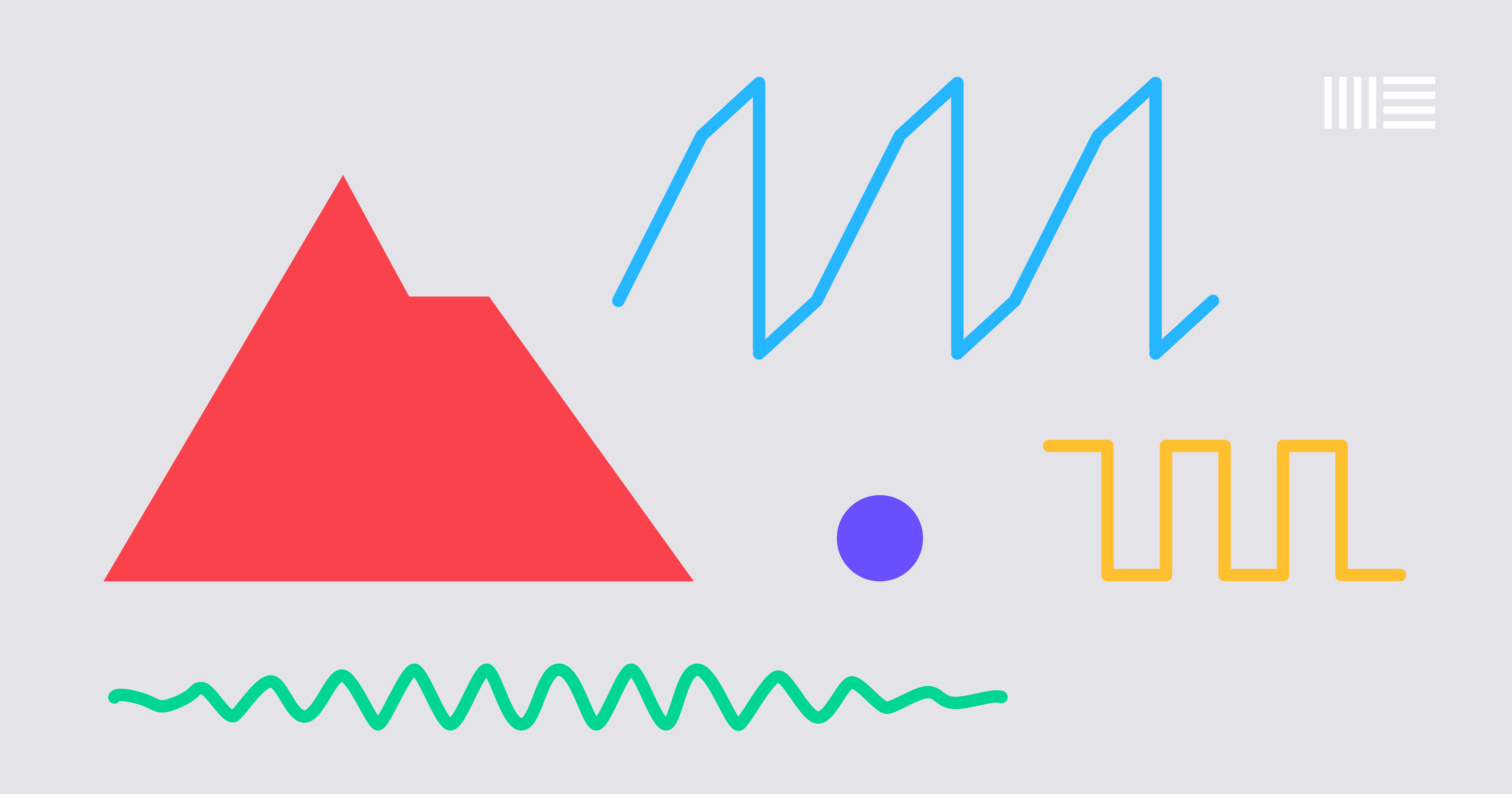
Learning Synths
Waveforms & Oscillators
A waveform is a visual representation of a continuous tone that you can hear. In analog synthesis the waveforms are somewhat simple and repetitious (with the exception of noise), because that was easier to generate electronically. But any sustaining, or ongoing sound can be analyzed and represented as a waveform. So any type of synthesizer has what are referred to as waveforms, even though they may be generated by sampling (audio recordings of sound), analog circuitry, DSP-generated signals, and various forms of digital sound manipulation (FM, Phase Modulation, Phase Distortion, Wavetables, Additive Synthesis, Spectral Resynthesis and much more). However they are created, we generally refer to the sonic building block of sound as a waveform.
Simply stated, an oscillator is the electronic device, or part of a software synthesizer design that generates a waveform. In an analog synthesizer it is a physical circuit made up of electronic components. In digital/DSP-driven synthesizers (including soft synths) it is a part of the software code that is instructed/coded to produce a waveform, or tone.
Listen to the sound in the Buzzy Bee video and then check it out for yourself via the link below.

Learning Synths
Listen to the sound in the Sound Waves video and then check it out for yourself via the link below.

Learning Synths
Harmonics
Harmonics are the building blocks of sound that make one instrument, or waveform sound different from another. The level of each harmonic as they exist in nature (the harmonic series) together determine the timbral “fingerprint” of a sound, so we can recognize the difference between a clarinet and a piano. Often these harmonics change in their volume level and tuning as a sound develops, and might decay away: the more this happens the more complex, and “alive” a sound will seem to our ears. You can now go back to the original Waveform poster and understand that it is the harmonic “signature” of each waveform that gives it the sonic characteristics that we used to describe each one.
Filters
The general dictionary definition of a filter is a device that when things pass through it, the device may hold back, lessen or remove some of what passes through it. In synthesis a filter is used to reshape the harmonic content from the oscillator-generated waveform. The above poster describes three of the most common types of filters from analog synthesis, but many more have been developed which have different characteristics.Different brands of synthesizers have their own filter designs that have a special sound, and many of those classic designs are much sought-after and emulated in modern digital and software synthesizers.

Learning Synths
Filter Resonance

Learning Synths
Amp
The poster says it straight up – an amp increases and decreases volume of the sound that is output by the oscillator. If the sound only stayed at a single level as determined by the amp level sounds would be pretty boring. Thankfully we have many ways to vary that sound output, via envelopes, LFOs, step-sequencers and more. Read on…

Learning Synths
Envelopes
An envelope (originally called a contour generator by Bob Moog!) is a building block of a synthesizer that changes the level of something over time. This is needed to recreate the complex characteristics of different sounds. The three main aspects of a sound that are usually shaped in this way are pitch (oscillator frequency), timbre (filter cutoff) and volume (amp level). Just describing the volume characteristics of a sound, some instruments keep sustaining (like a pipe organ), others decay in volume over time (a plucked string of a guitar, or a struck piano note). In modern synthesizers, and in modular synths an envelope can usually be routed to most any parameter to change its value over time. The poster describes what is called an ADSR envelope, but there are many types, some with many more steps able to be defined, and on the flip side some are simpler, with only Attack and Release stages.

Learning Synths
LFO- Low Frequency Oscillator
An LFO is another type of oscillator that is dedicated for use to modulate, or affect another parameter of the sound in a cyclic fashion (meaning it keeps repeating).So it seems related to the function of envelopes, but it behaves differently in the sense that you can’t shape it as finitely. Yet it is easier to use for simple repeatable things like vibrato (pitch modulation), tremolo (amp level modulation), and panning (changing the amp output from left to right in a stereo field).
How can we use MIDI to interact with these parameters?
The most common use of MIDI to affect these parameters is to map, or assign a physical controller on your keyboard or control surface to directly control a given parameter. We do this when we don’t have the instrument right in front of us (it may be a rack-mount device, or a soft-synth), or it doesn’t have many knobs/slider/controls on the front panel.You would use CC numbers (Control Change) and match up the controller object (slider, encoder, whatever) to the destination parameter you wish to control.
Then when you move the controller it sends a steady stream of values (128 to be exact) to move/change the destination. A device may have those CC numbers hard set, or they can be freely assigned. Most soft synths have a “learn” function, where the synth “listens” or waits to receive an incoming MIDI message and then sets is automatically, so you don’t even need to know what CC number is being used.
Some synths use what are called RPN (Registered Parameter Numbers) and NRPN (Non-Registered Parameter Numbers) to control parameters. While more complicated to set up, these types of message offer finer resolution than CCs (16,384 steps), but do the same thing. Soon there will be MIDI 2.0 which brings 32 bit resolution or 2,147,483,647 steps. Yes, that number is correct!
From a performance standpoint, a cool benefit of using MIDI to control a parameter is you can choose to have a different type of controller interact with the given parameter than your hardware device offers. Some people like to use a ribbon to do pitch bends rather than a wheel. Or to sweep the cutoff of a filter using an X/Y pad rather than a knob. Or route keyboard after-touch to bring in vibrato or tremolo rather than a Mod Wheel (OK, this one went beyond using CCs but you get the picture).
Another nice way to use MIDI is to assign sliders or knobs to an ADSR envelope in a product that doesn’t already have dedicated knobs to control the stages. So now you can easily soften, or slow up the attack on a sound (or speed it up), lengthen or tighten up the release (what happens when you take your finger off the key).
Using MIDI really becomes an aid when I am recording. If were to record only audio, as I play a synth I need to get all of my interactions with the sound perfect during the performance. My pitch bends, my choices of when to add vibrato and how much to add, and any other interactions I want to make with the sound. I can’t fix them later, as they are forever frozen in the audio I recorded. If I capture my performance using MIDI, each of those aspects are recorded as different types of MIDI messages/data, and I can then go back in and adjust them later. Too much vibrato on that one note? Go into event edit and find the stream of MIDI CC#1 messages and adjust it to taste. Even better, I can record my performance and not worry about other gestures/manipulation I might want to make, and then go back and overdub, or add them in later. So I can manipulate the sound and performance in ways that would be impossible to do in real-time. When I get the performance shaped exactly as I want it, I can then bounce the MIDI track to audio and I’m done. Thank you MIDI!
by Jerry Kovarsky, Musician and Author
A Brief History of the Minimoog Part I
Follow the life of the Minimoog Synthesizer from its inception through its prolific contributions to poplular music throughout the last 4 decades. In this first installment documenting the journey of the Minimoog synth through the 1970’s, we explore the musicians and the people that were instrumental in bringing the instrument to prominence. We also sit with one of Moog Music’s earliest engineers, Bill Hemsath, who recalls the process of the Minimoog’s birth and sheds some light on what sets the Moog synthesizer apart from other analog synths.
by Moog Music
A Brief History of the MiniMoog Part II
Chronicling the influential artists who used the Minimoog Model D to explore new genres and discover the sounds of tomorrow.
by Moog Music












